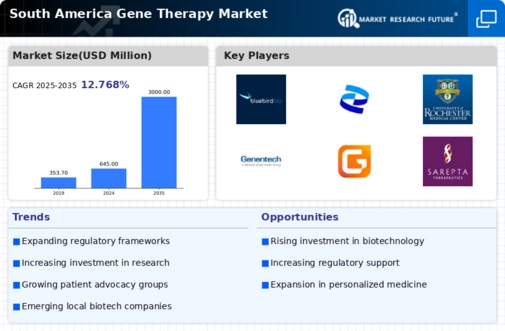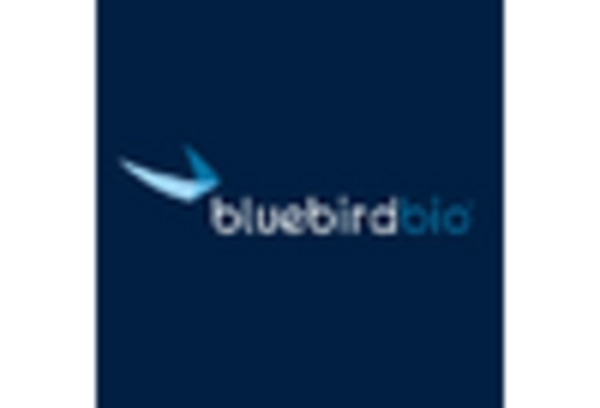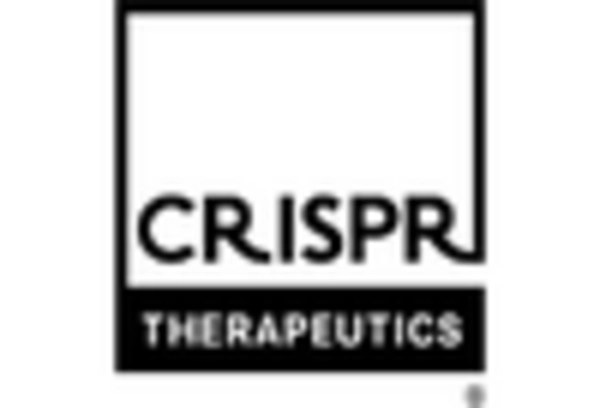Government Initiatives and Funding
Government initiatives aimed at promoting biotechnology and gene therapy research are pivotal in shaping the gene therapy market in South America. Various countries in the region have established funding programs and grants to support innovative research projects. For instance, Brazil's National Council for Scientific and Technological Development has allocated substantial resources to biotechnology, including gene therapy. This financial backing not only encourages academic institutions and private companies to engage in gene therapy research but also fosters collaboration between public and private sectors. As a result, the availability of funding is expected to enhance the development of novel gene therapies, ultimately benefiting patients and healthcare providers alike.
Rising Prevalence of Genetic Disorders
The increasing incidence of genetic disorders in South America is a crucial driver for the gene therapy market. Conditions such as cystic fibrosis, hemophilia, and muscular dystrophy are becoming more prevalent, necessitating innovative treatment options. According to health statistics, genetic disorders affect approximately 1 in 200 births in the region, highlighting a significant patient population in need of advanced therapies. This growing demand for effective treatments is likely to propel investments in gene therapy research and development, as healthcare providers seek to address these unmet medical needs. Furthermore, the rising burden of genetic diseases places additional pressure on healthcare systems, prompting governments and private entities to explore gene therapy solutions as a viable alternative to traditional treatments.
Technological Advancements in Gene Editing
Technological advancements in gene editing techniques, such as CRISPR-Cas9, are transforming the landscape of the gene therapy market in South America. These innovations enable precise modifications to genetic material, offering new avenues for treating genetic disorders. The accessibility of these technologies is increasing, with several research institutions in South America adopting them for therapeutic applications. As a result, the cost of developing gene therapies is likely to decrease, making them more accessible to a broader patient population. Moreover, the potential for personalized medicine through gene editing could lead to more effective treatments, further driving the growth of the gene therapy market in the region.
Increasing Demand for Personalized Medicine
The growing demand for personalized medicine is reshaping the gene therapy market in South America. Patients are increasingly seeking tailored treatment options that address their unique genetic profiles. This trend is prompting healthcare providers to explore gene therapies that can be customized to individual patients, enhancing treatment efficacy. The rise of genomic sequencing technologies has made it feasible to identify specific genetic mutations, paving the way for targeted gene therapies. As a result, the market for personalized gene therapies is likely to expand, driven by both patient demand and advancements in genetic research. This shift towards personalized medicine is expected to play a crucial role in the future of the gene therapy market in the region.
Collaborations Between Academia and Industry
Collaborations between academic institutions and industry players are emerging as a significant driver for the gene therapy market in South America. These partnerships facilitate the exchange of knowledge, resources, and expertise, accelerating the development of innovative gene therapies. Universities are increasingly partnering with biotech companies to translate research findings into clinical applications. This synergy not only enhances the research capabilities of academic institutions but also provides industry players with access to cutting-edge scientific discoveries. As a result, the number of clinical trials and new gene therapy products entering the market is expected to rise, contributing to the overall growth of the gene therapy market in the region.


















Leave a Comment